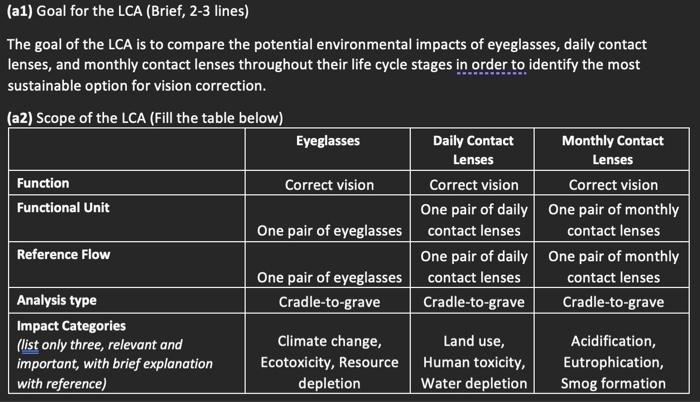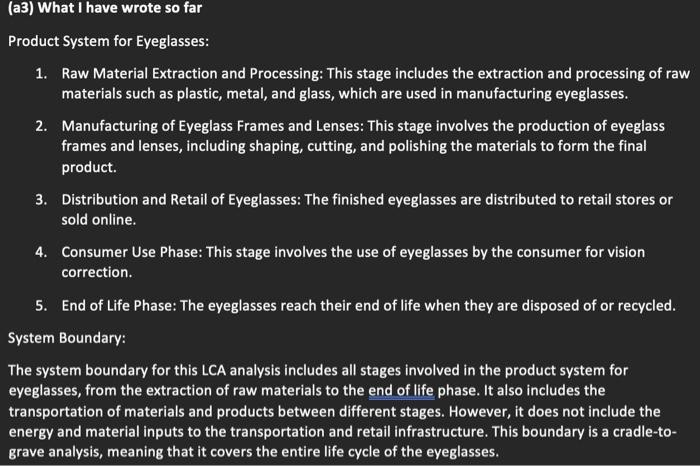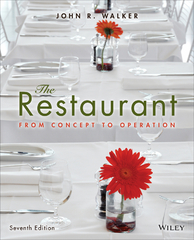(a) Your_manager_assigned_you_a_task_on_assessing_the_whole_life_cycle_of_three_alternatives_for_vision_correction. The_focus_of_this_comparative_LCA_study_will_be_on_eyeglasses, daily_contact_lenses, and_monthly_contact_lenses. The_aim_is_to_understand_how_much_each_of_them_has_potential_environmental_impacts_during_its_life_cycle. A_clear_interpretation_of_inventory_analyses_will_be_presented_along_with_the_impact_assessment_of_these_three_products.
(a3) Draw_the_product_system_for_eyeglasses only. Clearly_show_the_system_boundary_for_your_analysis_type.
In the photos, you can see my anwers to part a1 to a3. Please help me to solve a3.
(a1) Goal for the LCA (Brief, 2-3 lines) The goal of the LCA is to compare the potential environmental impacts of eyeglasses, daily contact lenses, and monthly contact lenses throughout their life cycle stages in order to identify the most sustainable option for vision correction. (a2) Scope of the LCA (Fill the table below) Product System for Eyeglasses: 1. Raw Material Extraction and Processing: This stage includes the extraction and processing of raw materials such as plastic, metal, and glass, which are used in manufacturing eyeglasses. 2. Manufacturing of Eyeglass Frames and Lenses: This stage involves the production of eyeglass frames and lenses, including shaping, cutting, and polishing the materials to form the final product. 3. Distribution and Retail of Eyeglasses: The finished eyeglasses are distributed to retail stores or sold online. 4. Consumer Use Phase: This stage involves the use of eyeglasses by the consumer for vision correction. 5. End of Life Phase: The eyeglasses reach their end of life when they are disposed of recycled. System Boundary: The system boundary for this LCA analysis includes all stages involved in the product system for eyeglasses, from the extraction of raw materials to the end of life phase. It also includes the transportation of materials and products between different stages. However, it does not include the energy and material inputs to the transportation and retail infrastructure. This boundary is a cradle-tograve analysis, meaning that it covers the entire life cycle of the eyeglasses. (a1) Goal for the LCA (Brief, 2-3 lines) The goal of the LCA is to compare the potential environmental impacts of eyeglasses, daily contact lenses, and monthly contact lenses throughout their life cycle stages in order to identify the most sustainable option for vision correction. (a2) Scope of the LCA (Fill the table below) Product System for Eyeglasses: 1. Raw Material Extraction and Processing: This stage includes the extraction and processing of raw materials such as plastic, metal, and glass, which are used in manufacturing eyeglasses. 2. Manufacturing of Eyeglass Frames and Lenses: This stage involves the production of eyeglass frames and lenses, including shaping, cutting, and polishing the materials to form the final product. 3. Distribution and Retail of Eyeglasses: The finished eyeglasses are distributed to retail stores or sold online. 4. Consumer Use Phase: This stage involves the use of eyeglasses by the consumer for vision correction. 5. End of Life Phase: The eyeglasses reach their end of life when they are disposed of recycled. System Boundary: The system boundary for this LCA analysis includes all stages involved in the product system for eyeglasses, from the extraction of raw materials to the end of life phase. It also includes the transportation of materials and products between different stages. However, it does not include the energy and material inputs to the transportation and retail infrastructure. This boundary is a cradle-tograve analysis, meaning that it covers the entire life cycle of the eyeglasses








